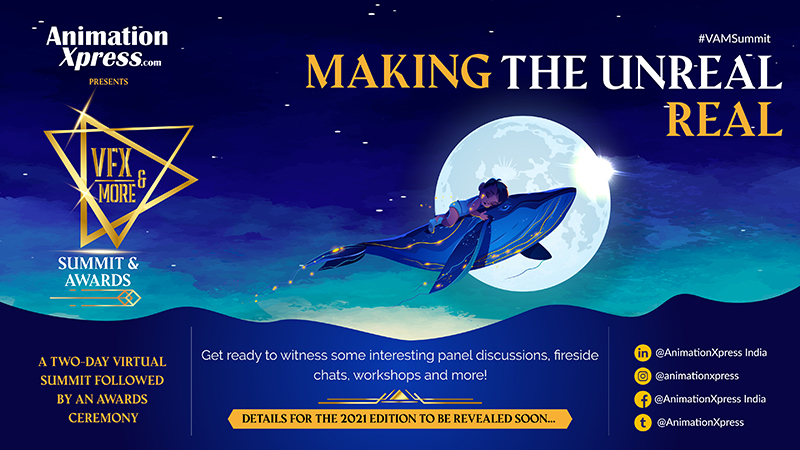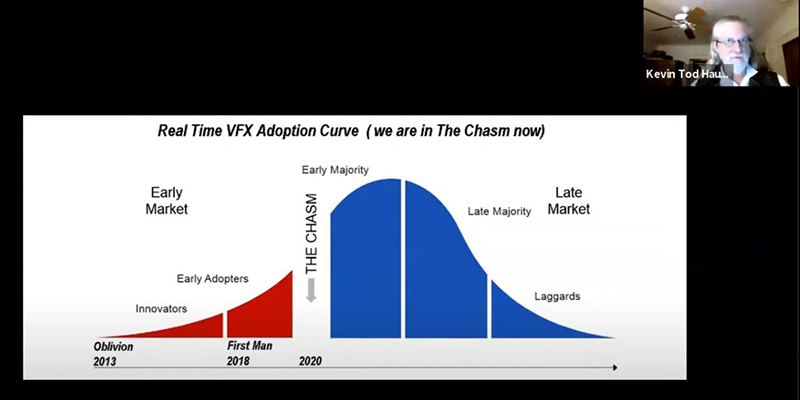
Witnessing the changing trends in the VFX industry, the second day of VAM (VFX and more) started off with industry veteran & VFX designer Kevin Tod Haug talking about how the industry has evolved from stitching images to creating photographic effects to creating full-fledged motion pictures.
From the first motion picture made in 1895 till the current era, Haug explored how far the industry has come and how VFX (visual effects) and CG (computer graphics) compliment it to achieve spectacular results.

Haug’s illustrious career includes Hollywood majors like Quantum of Solace, American Gods, Micheal Jackson’s song “Scream” and many more.
The Lumière brothers
The first motion pictures, Haug informs, were produced between 1895 and 1905 by Auguste and Louis Lumière, famously known as The Lumière brothers, using their proprietary cinématographe motion picture system. The motion pictures were carefully composed and filmed for its time. We can say that the Lumière brothers essentially invented Cinema.
Georges Méliès – World’s first VFX supervisor
Two years since the first motion, another veteran, French illusionist, Georges Méliès started producing his motion pictures using miniatures, puppet animations and many other pioneering techniques. He is considered as the inventor of special effects in movies. As Haug quotes, “A magician, Georges Méliès invented things like the cut, dissolve, multi pass compositing, miniatures, puppet animation and he made cinema into a spectacle.”
Haug shared that before Méliès there wasn’t any cinema as we understand it and therefore he was the forerunner of visual effects because he was definitely the very first visual effects supervisor.
Linwood G. Dunn
Haug shared, “By 1941, Linwood G. Dunn had invented optical printer and this was the beginning of visual effects moving from the motion picture set into post-production, where the movies could be better controlled and you could start telling stories in detail.”
Douglas Trumbull
Fast forward 1982, Douglas Trumbull, American film director, special effects supervisor, and inventor made industry benchmarks by making movies 2001: A Space Odyssey, Close Encounters of the Third Kind, Star Trek: The Motion Picture, Blade Runner. “The thing about Blade Runner is that it told everybody what visual effects movies ought to be about. It was entirely photo mechanical, there’s not a technique in Blade Runner that Méliès didn’t invent, they were just getting better and better,” Haug further elaborated.
Another motion picture Tron made in 1982 left a cultural effect on the audience, the era of computer graphics had begun. Computer-generated graphics and effects such as fire, water particles, explosions, CG environments etc. became more generally used. A number of movies have now in present times made box office hits such as Planet of the Apes, Black Panther, all with the help computer graphics and visual effects.
Haug shared, “At the end of this photo mechanical paradigm which is suddenly a digital paradigm, we are now at the beginning of another paradigm, and my take on it as a production guy is that what has happened since Tron in the last four years is that VFX is shifting gradually away from the set, away from creatives that work on production into post-production form where things can be more easily controlled and the quality goes up.”
As we see the world around us, we realize how far have we come. From trying to portray visual images a thousand years ago to being able to create our own reality, this industry has seen a steady growth curve. The VFX we see today are things people could only imagine merely a few decades ago. The increased efficiency, creativity and sustainability of the industry has led to new talents contributing their ideas. As dynamic as the VFX industry is, not only youngsters but people of all ages are now intrigued being a part of it.
Production as we know it
Haug shares that production happens when a group of people are out trying to capture images and his job is to keep an eye on things and advice as things go along. Speaking about what it means to be in the VFX profession, Haug recounted, “My mentor Mike Fink said once, ‘In visual effects, paranoia is a virtue and this virtue is the basis for all your success.'”
But things have drastically changed over the years. A large part of production business has moved into post-production. He asserts, “That’s where we are now where post becomes at least as big as production and often in terms of money, it dwarfs everything else.”
Virtual Production or Rear Projection?
The growing trend of virtual production involving LED volumes and in-camera visual effects has caused quite a buzz in the motion pictures industry. For Haug, virtual production is not far divorced from rear projections that have been a part of the industry.
Rear Screens have been around almost as soon as there were movies. King Kong and Laurel and Hardy are examples of rear screens. He added that even he has used rear screen in Fight Club.
He shared, “The problem with rear screens is that it is so damn restrictive. Moving the camera meant motion control. Changing anything on the day meant you have to go back, do it all over again and come back again. Things had to be so precise but you could do it. For instance, the movie “Oblivion”, it is hard to believe but it is ten years old. Oblivion was nothing but projection. There was nothing going on there except for brighter and steadier projectors than what Laurel and Hardy were doing.”
With a big old screen and a whole bunch of projectors, he shared, “what you get is an amazing look on the foreground.”
He added, “You don’t have the artefacts of a blue screen to deal with and all the rest of it. It just takes planning and it gets done in production. Modern filmmakers don’t have to give up what they used to have to give up to do projection.”
Haug hasn’t fully come around to the usage of the term “Virtual production”. Having seen the industry grow and use a variety of techniques to create images, Haug feels there is something remiss about calling this process ‘virtual production.
Expressing his disagreement with the usage of the term, he shared, “I go on record as having a problem with calling this stuff virtual production. Virtual production is another way of saying previz. The projection that is on your wall that you can photograph. Lots of people made and they delivered it and it is finished. And if you’re getting final pixels out of your production camera, you’re done. That is not virtual at all, that is what cinematographer’s manual called up until the newest one; process work.”
Haug opined that it has been ‘process work’ for a hundred years and now we have fixed a lot of the horrible problems that we used to have and all we really have at the moment is a political problem.
Adoption Curve
With the help of the adoption curve, he shares that for any new technology, there are the innovators, the early adopters, the early majority and then there’s people who still don’t like their cellphones.
Speaking about the chasm between technology and its adoption, he shares, “But in the meantime, there’s this gap. Here we are in 2020, where it is known as the chasm. There is a desire but nobody’s got the guts to do it. And it is no longer going to be these crazy, very rich and powerful directors forcing that you can use this technology. This technology which by its very nature is very expensive, some of the techniques are expensive but if you lay them against months of post, is it expensive? It just needs thinking differently.”
TV Series: Run
Citing another example of rear projections, Haug shared, “Television series called Run used Unreal Engine and they were tracking the camera. What is interesting about Run is how it was achieved; there are 21 televisions sets outside those windows. They are all being projected to from Unreal Engine. There is not even a video server involved which is, to be quite honest, insanity. But they did it.”
There is an episode after episode on a train with 21 television sets; all running in sync, all seen in the background.
He added, “Granted what you’re seeing is live-action footage that is kind of being little tweaked. Primarily all they’re doing is keeping the horizontal line where it belongs but in end, I ask, is that not more beautiful than what you could have got if you were literally doing it on a train?
Because you couldn’t do nearly as much work and if you were doing it against a blue screen, it would have taken twenty times as long and probably cost at least as much.”
Haug concluded, “This paradigm shift which is coming up is all about production.”
VFX is seeping into pre-production, production and post-production in the coming days.


